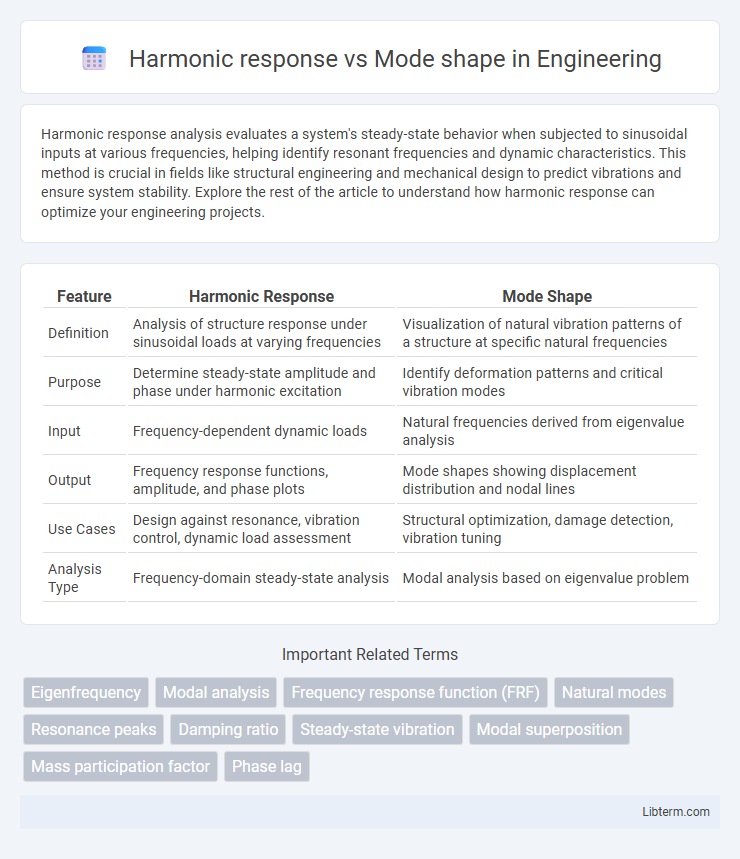Harmonic response analysis evaluates a system's steady-state behavior when subjected to sinusoidal inputs at various frequencies, helping identify resonant frequencies and dynamic characteristics. This method is crucial in fields like structural engineering and mechanical design to predict vibrations and ensure system stability. Explore the rest of the article to understand how harmonic response can optimize your engineering projects.
Table of Comparison
| Feature | Harmonic Response | Mode Shape |
|---|---|---|
| Definition | Analysis of structure response under sinusoidal loads at varying frequencies | Visualization of natural vibration patterns of a structure at specific natural frequencies |
| Purpose | Determine steady-state amplitude and phase under harmonic excitation | Identify deformation patterns and critical vibration modes |
| Input | Frequency-dependent dynamic loads | Natural frequencies derived from eigenvalue analysis |
| Output | Frequency response functions, amplitude, and phase plots | Mode shapes showing displacement distribution and nodal lines |
| Use Cases | Design against resonance, vibration control, dynamic load assessment | Structural optimization, damage detection, vibration tuning |
| Analysis Type | Frequency-domain steady-state analysis | Modal analysis based on eigenvalue problem |
Introduction to Harmonic Response and Mode Shape
Harmonic response analysis evaluates a structure's steady-state response to sinusoidal loads at varying frequencies, providing insight into vibrational behavior and resonance characteristics. Mode shape represents the specific deformation pattern of a structure at a natural frequency, revealing areas of maximum displacement and stress during vibration. Understanding both harmonic response and mode shapes is essential for predicting dynamic performance and preventing structural failure due to resonance.
Fundamental Concepts of Harmonic Response
Harmonic response analysis evaluates a structure's steady-state behavior under sinusoidal loading, quantifying amplitude and phase at various frequencies, while mode shapes represent the characteristic deformation patterns at natural frequencies. Understanding fundamental concepts of harmonic response involves recognizing resonance phenomena when excitation frequencies align with natural modes, leading to amplified responses. The interplay between harmonic excitation and mode shape dictates the dynamic amplification and structural stability under periodic forces.
Understanding Mode Shapes in Structural Dynamics
Mode shapes in structural dynamics represent the specific deformation patterns a structure undergoes at its natural frequencies, crucial for identifying vibration characteristics. Unlike harmonic response, which examines the steady-state response under sinusoidal loading, mode shapes provide insight into the inherent dynamic behavior without external forcing. Understanding mode shapes enables engineers to predict potential failure points and design structures for optimal vibration control and stability.
Key Differences Between Harmonic Response and Mode Shape
Harmonic response analysis evaluates the steady-state behavior of structures under sinusoidal loads, highlighting amplitude and phase variations at specific frequencies, while mode shape analysis identifies the natural vibration patterns or deformation shapes corresponding to each resonant frequency. Harmonic response focuses on dynamic response to external excitation over a frequency range, whereas mode shape reveals inherent structural characteristics independent of forcing functions. Key differences include harmonic response's depiction of response magnitudes and phase shifts versus mode shape's visualization of displacement patterns, aiding distinct engineering applications such as vibration suppression and modal testing.
Importance of Harmonic Response Analysis
Harmonic response analysis identifies system behavior under sinusoidal excitation, revealing resonance frequencies and amplitude magnifications critical for avoiding structural failures. Understanding mode shapes helps visualize deformation patterns at specific natural frequencies, yet harmonic response quantifies system response to real-world cyclic loads. This analysis is essential for designing components in automotive, aerospace, and civil engineering to ensure durability and operational safety under vibrational loads.
Role of Mode Shapes in Vibration Analysis
Mode shapes represent the distinct deformation patterns of a structure during vibration at specific natural frequencies, serving as fundamental indicators in vibration analysis. They enable precise identification of resonance conditions by showing how different parts of the structure move relative to each other under dynamic loads. Understanding mode shapes is crucial for predicting stress concentrations, optimizing design to reduce vibrational impact, and improving the accuracy of harmonic response analyses.
Applications of Harmonic Response in Engineering
Harmonic response analysis is essential in engineering for predicting the steady-state behavior of structures subjected to sinusoidal loadings, such as rotating machinery, bridges, and automotive components. It helps identify resonant frequencies to prevent excessive vibrations that could lead to fatigue or failure, making it critical in the design of aerospace structures and vibration isolation systems. Mode shape analysis complements this by revealing inherent deformation patterns, but harmonic response specifically quantifies amplitude and phase under dynamic loading, guiding engineers in optimizing damping and stiffness characteristics.
Application of Mode Shapes in Structural Design
Mode shapes reveal the deformation patterns of structures at specific natural frequencies, critical for identifying potential failure points during dynamic loading. Engineers apply mode shapes to optimize structural elements by enhancing stiffness and damping in areas of maximum displacement or stress, improving overall resilience. Understanding harmonic response involves analyzing these mode shapes to predict vibrational behavior under periodic forces, ensuring safety and performance in design.
Interrelation Between Harmonic Response and Mode Shapes
Harmonic response analysis evaluates a structure's steady-state response to sinusoidal loads by incorporating natural frequencies and damping characteristics derived from mode shapes. Mode shapes represent the deformation patterns at specific eigenfrequencies, directly influencing the amplitude and phase of harmonic responses. Understanding the interrelation between harmonic response and mode shapes enables accurate prediction of resonant behavior and dynamic amplification in engineering systems.
Conclusion: Choosing the Right Approach for Dynamic Analysis
Harmonic response analysis is ideal for evaluating system behavior under steady-state sinusoidal loads, providing precise frequency response characteristics. Mode shape analysis effectively identifies natural vibration patterns and frequencies critical for avoiding resonance conditions. Selecting the appropriate approach depends on whether the focus is on forced vibration behavior or inherent structural dynamics to ensure accurate dynamic analysis results.
Harmonic response Infographic

 libterm.com
libterm.com